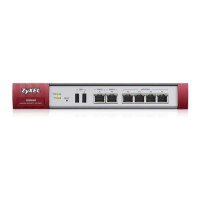Chapter 42 IDP Commands
ZyWALL Series CLI Reference Guide
351
42.2.1.1 Activate/Deactivate IDP Example
This example shows how to activate and deactivate signature-based IDP on the Zyxel Device.
security-service ips
inspect {all-traffic | by-
policy}
Sets how the security service inspects traffic.
all-traffic: The security service inspects all traffic passing through the
Zyxel Device.
by-policy: The security service inspects traffic only when its profile is
bound to a security policy.
For information on binding a security service profile to a security policy, see
Section 29.2.1 on page 226.
[no] idp
{anomaly | signature |
system-protect} activate
Enables IDP signatures, anomaly detection, and/or system-protect. IDP
signatures use requires IDP service registration. If you don’t have a standard
license, you can register for a once-off trial one. The
no command
disables the specified service.
idp system-protect
deactivate
Disables system-protect.
show idp
{anomaly | signature |
system-protect} activation
Displays the activation status of the anomaly detection, IDP signature, or
system protect service.
show idp rate_based_sig
<profile name>
Displays the specified rate based signature profile.
idp reload
Recovers the IDP signatures. You should only need to do this if instructed to
do so by a support technician.
idp session-block {activate
| deactivate}
Activate a specific RDP signature.
Note: This command is aimed at regular users. You should only use
it if instructed to do so.
idp session-block period
{1–3600}
Sets the time in seconds that the Zyxel Device blocks an IP address which
matches the
idp session-block signature.
Table 192 IDP Activation
COMMAND DESCRIPTION
Router# configure terminal
Router(config)# idp signature activate
Router(config)# show idp signature activation
idp signature activation: yes
Router(config)# no idp signature activate
Router(config)# show idp signature activation
idp signature activation: no

